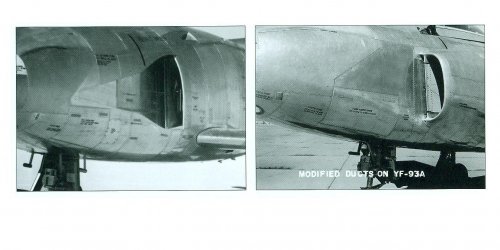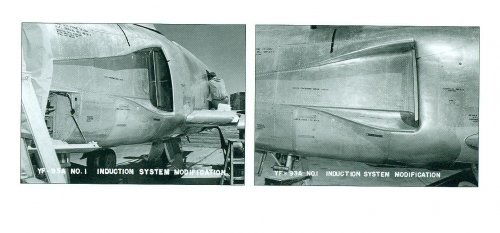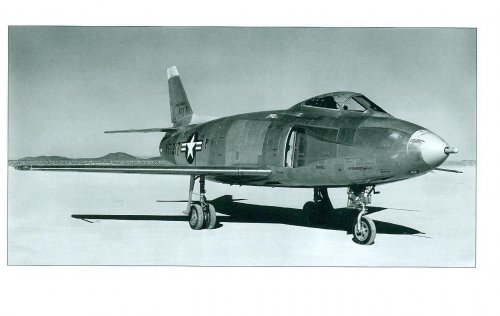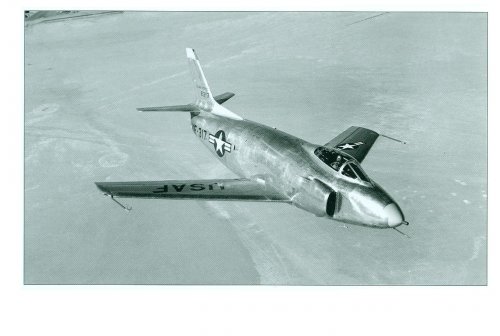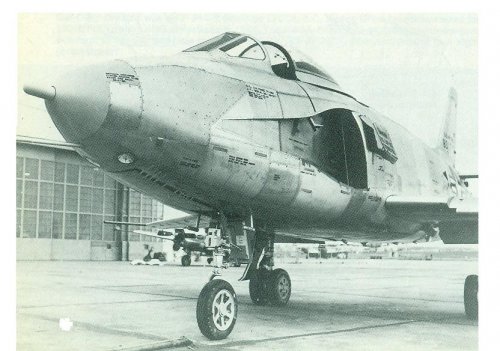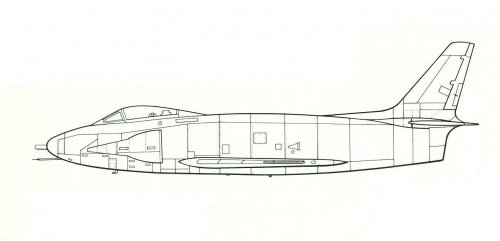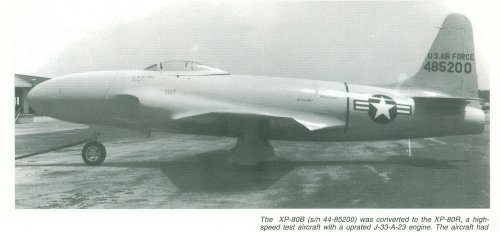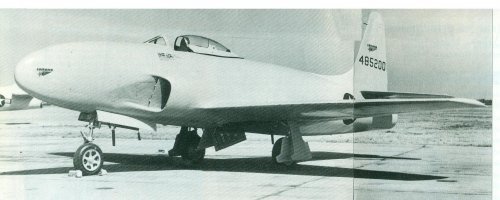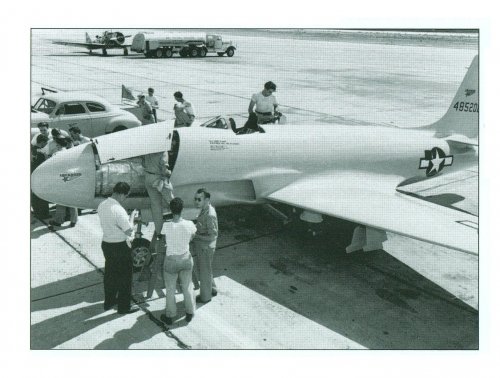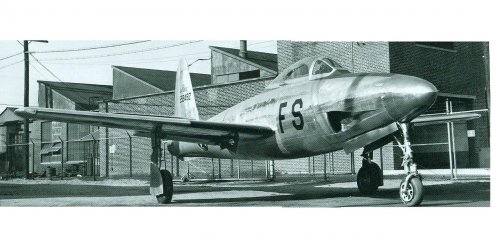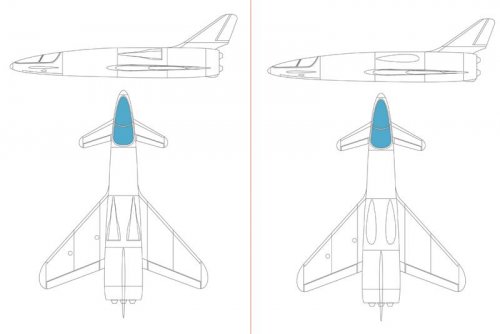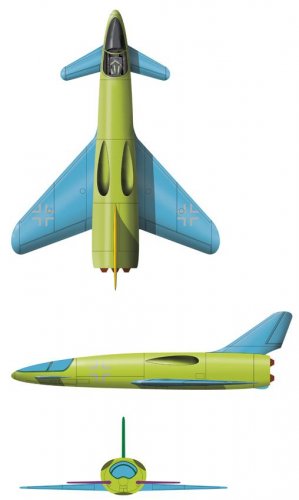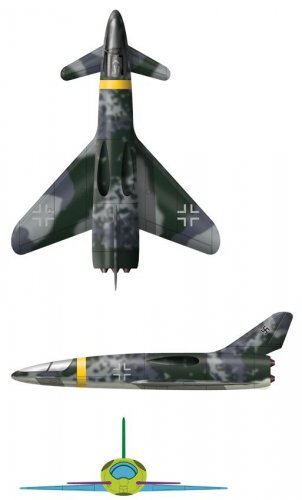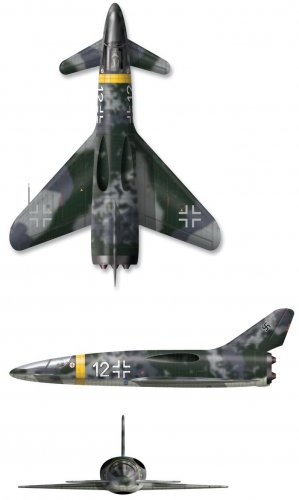You are using an out of date browser. It may not display this or other websites correctly.
You should upgrade or use an alternative browser.
You should upgrade or use an alternative browser.
Dornier Canard Design
- Thread starter Flitzer
- Start date
_Del_
I really should change my personal text... Or not.
- Joined
- 4 January 2012
- Messages
- 1,315
- Reaction score
- 1,812
alfakilo said:Flitzer said:As a point of interest, have any aircraft been built and successfully put into service using wing boundary layer suction intakes?Many thanksP
Perhaps the lessons learned from the XF-93 and its unique inlet design might be helpful to your question. While the NACA inlet theory "worked", it apparently didn't "work" well enough...and was replaced by conventional intakes.
The XF-93 lessons were simply re-learning the lessons of Lockheed's attempt to modify the XP-80B prototype with NACA inlets as the XP-80R. "Racey" did manage to capture the world speed record after a redesign with conventional cheek inlets, and the second XF-93 prototype likewise featured cheek inlets as shown in the photo (but not line-drawing) Justo provides above.
- Joined
- 25 June 2009
- Messages
- 14,754
- Reaction score
- 6,155
Just realized I made a big mistake a few posts above by mentioning the Northrop X-21 as a "BLC" (Boundary Layer Control) aircraft. In actual fact it was an LFC (Laminar Flow Control) demonstrator, which is a very different thing altogether!!! :-[ :'(
- Joined
- 11 March 2006
- Messages
- 8,625
- Reaction score
- 3,806
The first/left one seems actually to have "NACA ducts", which were, AFAIK developed
in 1945 in the US. So information about them probably wasn't available in Germany, even
during the last days of WW II. Only explanation could be a parallel development, or another
solution, that just looks like a NACA duct externally, but works different. Both not very
likely, I think, so I would stay with the second solution.
P.S.: ...and another reason: To incorporate something, that looks like a NACA duct, probably
would raise claims, thaht this was based on German developments, too ! Not that discussion
again, please !
in 1945 in the US. So information about them probably wasn't available in Germany, even
during the last days of WW II. Only explanation could be a parallel development, or another
solution, that just looks like a NACA duct externally, but works different. Both not very
likely, I think, so I would stay with the second solution.
P.S.: ...and another reason: To incorporate something, that looks like a NACA duct, probably
would raise claims, thaht this was based on German developments, too ! Not that discussion
again, please !
"P.S.: ...and another reason: To incorporate something, that looks like a NACA duct, probably
would raise claims, that this was based on German developments, too ! Not that discussion
again, please !
NACA was developing these kinds of inlets since the 1930s. As mentioned above, the Messerschmitt P.1110 and 1112 designs used a similar inlet - with two distinctive features - Messerschmitt would have used a fan mounted in front of the engine compressor shaft to suck off the boundary layer produced by the fuselage, and the inlet was placed in a way to contribute to area ruling. Area ruling was not incorporated in US designs until the redesign of the F-102.
would raise claims, that this was based on German developments, too ! Not that discussion
again, please !
NACA was developing these kinds of inlets since the 1930s. As mentioned above, the Messerschmitt P.1110 and 1112 designs used a similar inlet - with two distinctive features - Messerschmitt would have used a fan mounted in front of the engine compressor shaft to suck off the boundary layer produced by the fuselage, and the inlet was placed in a way to contribute to area ruling. Area ruling was not incorporated in US designs until the redesign of the F-102.
son altesse
ACCESS: Restricted
- Joined
- 20 June 2008
- Messages
- 17
- Reaction score
- 0
Just brilliant, as usual 
son altesse
ACCESS: Restricted
- Joined
- 20 June 2008
- Messages
- 17
- Reaction score
- 0
Hello Flitzer,
Still creating some models ! Nothing compare to yours brillants profils, great source of inspiration for generation of modelers
The last ones (sorry it´s in French, the pictures are enough):
http://www.master194.com/forum/viewtopic.php?f=4&t=33576&hilit=luft46&start=575
http://www.master194.com/forum/viewtopic.php?f=4&t=52209&hilit=luft46&start=125
http://www.master194.com/forum/viewtopic.php?f=4&t=44222&hilit=luft46&start=275
http://www.master194.com/forum/viewtopic.php?f=4&t=57947&hilit=luft46&start=100
http://www.master194.com/forum/viewtopic.php?f=4&t=50718&hilit=luft46&start=75
http://www.master194.com/forum/viewtopic.php?f=4&t=59607&hilit=luft46&start=50
http://www.master194.com/forum/viewtopic.php?f=4&t=43373&hilit=luft46&start=400
You can play to find your references in the differents posts, and to proof without any doubt that your drawing are very useful (and sure not only for me !)
Still creating some models ! Nothing compare to yours brillants profils, great source of inspiration for generation of modelers
The last ones (sorry it´s in French, the pictures are enough):
http://www.master194.com/forum/viewtopic.php?f=4&t=33576&hilit=luft46&start=575
http://www.master194.com/forum/viewtopic.php?f=4&t=52209&hilit=luft46&start=125
http://www.master194.com/forum/viewtopic.php?f=4&t=44222&hilit=luft46&start=275
http://www.master194.com/forum/viewtopic.php?f=4&t=57947&hilit=luft46&start=100
http://www.master194.com/forum/viewtopic.php?f=4&t=50718&hilit=luft46&start=75
http://www.master194.com/forum/viewtopic.php?f=4&t=59607&hilit=luft46&start=50
http://www.master194.com/forum/viewtopic.php?f=4&t=43373&hilit=luft46&start=400
You can play to find your references in the differents posts, and to proof without any doubt that your drawing are very useful (and sure not only for me !)
Similar threads
-
-
Axis Powers post-WWII airliner projects
- Started by Antonio
- Replies: 14
-
German early lock-on fire control
- Started by Wurger
- Replies: 3
-
-

